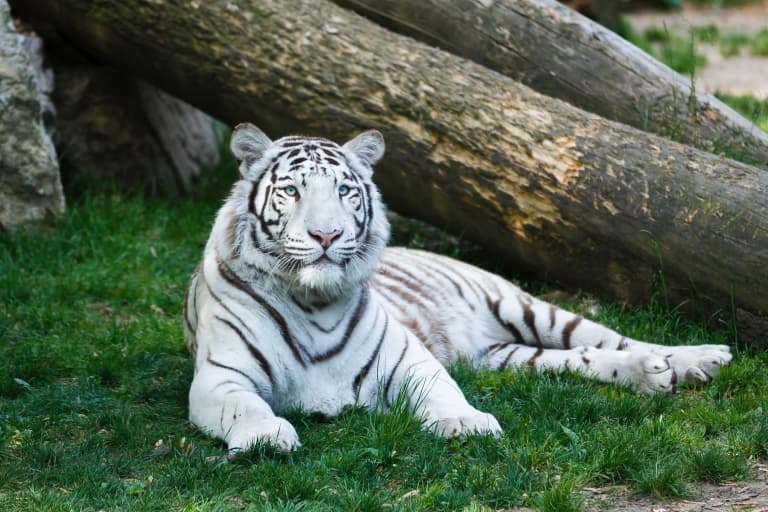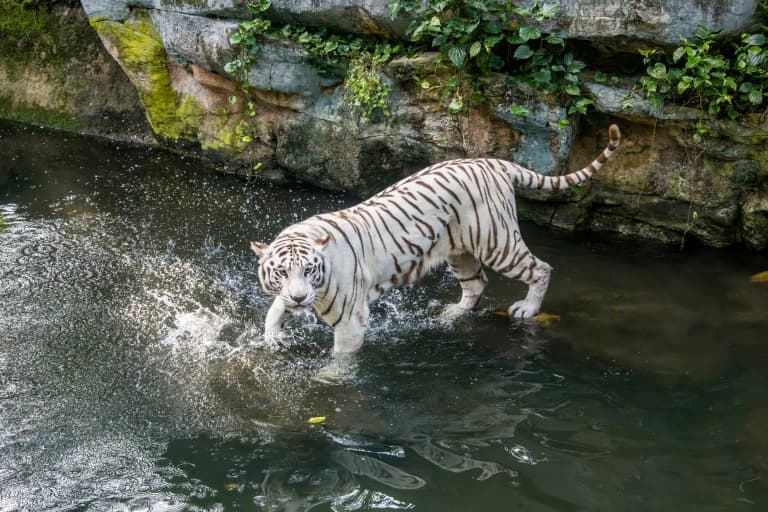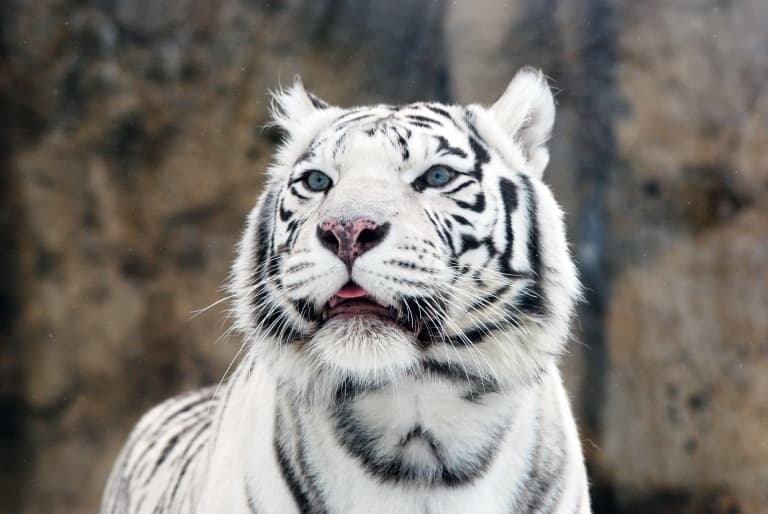White Tiger Profile
Zoos have a bit of a conundrum. Housing only animals that help science would make for a much smaller and less exciting selection for visitors, and giving every animal enough room to feel truly comfortable would result in most of them hiding away, never to be seen.
In both cases, the zoo would lose money from visitors that could be used to work on breeding programs, reintroduction efforts, and other conservation work.
So, conscientious organisations strike a balance: they’ll have some high-profile exhibits to bring in the money, and try to keep the net gain in favour of the environment and biodiversity as a whole. But not all zoos are conscientious, and plenty are barely regulated at all.
This, sadly, is why we have the white tiger; a sad abomination that should have remained a stunning mirage, in the deepest jungles of India.
The white tiger is a mainland tiger that has a genetic mutation causing a loss of pigmentation, that results in a distrinctive white coat with brown-black stripes.

White Tiger Facts Overview
| Habitat: | Captivity |
| Location: | Worldwide |
| Lifespan: | 20 years |
| Size: | 3 meters (10 ft) |
| Weight: | 440 – 510 lbs (200 – 230kgs) |
| Color: | White or cream fur and black, gray, or brown stripes |
| Diet: | Cattle, deer, chickens |
| Predators: | None |
| Top Speed: | 50 kph (30 mph) if healthy |
| No. of Species: |
1 |
| Conservation Status: |
Endangered |
The white tiger is a true freak of nature, and unfortunately often not in a good way. While they are reported in the wild from time to time in India, it’s not thought there are any in the wild today.
For a white tiger to be born, both parents must carry the unusual gene for loss of pigmentation, which occurs in perhaps 1 in 10,000 tiger births.
This rare mutation has been dangerously bred into unnatural captive populations and has sadly led to the vast majority of individuals being born as a fraction of the enigmatic and phenomenal predator it originated from.
While efforts are underway to stop this breeding, a tragic lack of regulation and enforcement allows the practice to continue and so-called zoos are profiting off the suffering of what was once a legendary and ethereal fluke of biology.
Interesting White Tiger Facts
1. They are white due to a lack of the pigment pheomelanin
Pheomelanin imparts a range of red and yellow pigments that produce the orange coloration of the tiger – and is found in other tigers, such as the bengal tiger, with orange color fur.
Like all tigers, their stripes are like fingerprints of humans. No two tigers have the same stripes. Each pattern is completely unique to each big cat, helping create a way to tell them apart.
An additional genetic condition can result in the tiger being almost completely white, with no stripes. This snow white tiger has pure white fur and is usually the rare result of crossbreeding and gene mutation.

2. They should be exceptionally rare
White tigers are often erroneously described as an endangered species, even in some zoos, and while they are very uncommon, there’s a good reason for this rarity.
As tigers, they are technically endangered, but they’re far from being a different species. White individuals are the product of an improbable genetic mutation in the single tiger species, Panthera tigirs; one which occurs in perhaps 1 in 10,000 tiger births.
The lack of orange pigment in their fur makes them less suited to their environment, and though a single white tiger may occasionally be born, the chances are slim that it would survive in the wild – as they lack necessary camouflage to hunt prey, and avoid predators.
The exact mechanism behind the mutation isn’t well understood, but its scarcity means that deliberate inbreeding has to occur to breed one on purpose. It’s a recessive allele, so both parents need to pass it on to the offspring.
3. There are likely zero wild white tigers
Of the roughly 4,500 tigers left in the wild today, it’s unlikely that any of them are white.
Despite hundreds of captive examples, this is not a trait that occurs – or should occur – frequently in the wild. 1

4. White bengal tigers are typically larger
White bengal tigers grow faster and are generally larger than the orange bengal tiger, both at birth, and when they are fully grown adults.
White tigers can grow up to 3m in length and weigh up to 510 lbs (230 kg).
5. Captive white tigers are inherently unhealthy
Nobody knows just how many white tigers are in captivity, but it’s thought that there are more than 200. Each of these comes from breeding within a very shallow gene pool.
Some say that every white tiger alive today is a descendent of a single individual caught in India, and bred incestuously with its offspring to expose the recessive alleles responsible for its white appearance.
There are far more serious considerations to in-breeding than the “ick factor”. Breeding with your siblings, offspring, or even cousins, offers limited genetic diversity and can lead to combinations of recessive, dangerous defects coming to light (it’s why histroical Nazis and royals always look a little bit malformed).
In the case of the white tiger, this in-breeding is necessary to bring out the colouration, but it comes at a cost to the tiger’s health, as many other conditions are expressed along with it.
The result is white fur, blue eyes, and often vision, kidney, and mental defects.

6. Malformed white tigers are sadly killed
It is possible to get lucky, and have a well-formed, beautiful white tiger with eyes that both point in the right direction and who has no problem telling an arse from an elbow, but it isn’t likely. The only way to guarantee this is to breed over and over again until the statistical laws come through.
And this means countless malformed, runty, and ultimately miserable animals either living short lives before they’re discarded as a by-product, or in some cases kept alive in discomfort until they die of their health problems.
Since there’s no formal census on tiger breeding in the US, and since most of these white tigers seem to be bred there, the numbers are hard to come by, but it may be that fewer than 1 in 30 or even 60 white tigers are healthy enough to live happy lives.
The remaining, malformed ones are killed.

7. They have been popular attractions in petting zoos
However, being healthy enough doesn’t mean they are granted that opportunity.
In fact, the tragic lack of regulation of smaller organisations in the US means that many white tigers and other big cats are routinely drugged and put on display in sick ‘petting zoo’ experiences for paying tourists.
In unregulated roadside ‘zoos’ these animals are taken from their mothers at a young age, kept in unsavoury conditions and have their welfare disregarded in favour of bringing in the crowds.
The cubs’ lives revolve around being kept awake, petted, put on display, and cruelly exploited in situations that are both dangerous for the people involved and the animals themselves.
8. AZA has forbidden breeding of white tigers
Since 2011, the Association of Zoos and Aquariums (AZA) has forbidden member zoos from breeding white tigers.
In Britain, British and Irish AZA (BIAZA) and in Europe, the European AZA (EAZA) are working along similar lines to ensure the safety and protection of all animals in zoos.
This is certainly a step in the right direction and offers promise to the countless potential monstrosities that could now be avoided, but AZA holds no power over non-member organisations, and so these tigers are still being mistreated in cheap roadside publicity stunts for money.
While AZA is trying to end private ownership of wild animals like this, they simply don’t have the teeth. 2 3

9. Roadside collections are still a problem
There are still AZA members with white tigers. While breeding is now forbidden, tigers already in existence deserve to be given a place to live out the rest of their days.
But there seems to be a lot of unofficial breeding still going on, and this is where the problem persists. Sanctuaries are taking animals in, but regulations are still not in place, or not enforced strongly enough to prevent the breeding and exploitation of white tigers.
10. For-profit zoos will always have this problem
There is no conservation merit to white tigers. They can’t be reintroduced, and neither do they truly belong in the wild.
But zoos will always need to balance the appeal of the animals they present against the impact they’re having on the environment.
If a zoo housed only animals that were part of reintroduction programs, customers would find them mostly boring, so they wouldn’t make money to do the work they’re doing.
However, not all zoos are doing work. Some are just glorified freakshows and circuses, and these are the ones with the least incentive to stop. While some organisations are catching illegal animal breeders and traders, the incentive remains as long as people keep visiting them.
By only attending accredited AZA zoos in the US or BIAZA/EAZA zoos in the UK and Europe respectively, you can avoid funding these unethical practices and keep exciting and exotic animals safe from exploitation. 4 5
White Tiger Fact-File Summary
Scientific Classification
| Kingdom: | Animalia |
| Phylum: | Chordata |
| Class: | Mammalia |
| Order: | Carnivora |
| Family: | Felidae |
| Genus: | Panthera |
| Species Name: |
Panthera Tigris |
Fact Sources & References
- Daphné Halley, Emily Lieb, and Ashley Wrean (2021), “The White Tiger’s Dark Past“, ArcGIS StoryMaps.
- BCR (2012), “Today at Big Cat Rescue AZA Says No More White Tigers or White Lions“, Big Cat Rescue.
- Dan Ashe (2020), “Tiger King and the Cruelty of Private Ownership of Wild Animals“, Association of Zoos and Aquariums.
- Kitty Block and Sara Amundson (2020), “200-plus wild animals removed from notorious Indiana roadside zoo“, A Humane World.
- SustainableSlice (2023), “Are Zoos Ethical Or Cruel? There’s No Simple Answer“, SustainableSlice.
